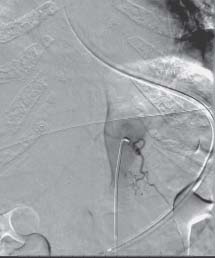Case 97 Spinal Arteriovenous Fistula
Pascal M. Jabbour and Erol Veznedaroglu
- A 77-year-old woman with a history of high blood pressure and diabetes presents to the emergency room for progressive weakness in her lower extremities.
- The weakness has been ongoing for the last 8 months, associated with episodes of bladder incontinence the last 3 weeks.
- She denies any lower back pain or radicular pain. There is no history of trauma.
- Neurologic examination reveals weakness in her proximal lower extremities’ muscle groups graded at 3/5 with spasticity. Distally, her strength is graded 4/5 on the Medical Research Council scoring system. Sensation is intact. She has increased deep tendon reflexes and a right Babinsky. Her rectal tone is normal. She has normal strength in the upper extremities.
- Magnetic resonance imaging (MRI) of the thoracic spine is shown in Fig. 97.1.
Fig. 97.1 T2-weighted magnetic resonance image (MRI), mid-sagittal section.
Fig. 97.2 Thoracic spine angiogram, anteroposterior view with selective injection of thoracic artery.
< div class='tao-gold-member'> Clinical Presentation
Clinical Presentation

 Questions
Questions Answers
Answers


